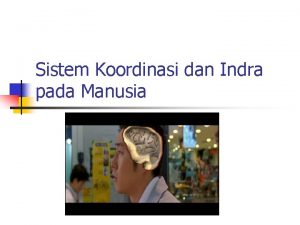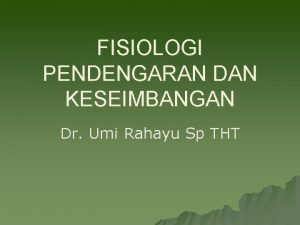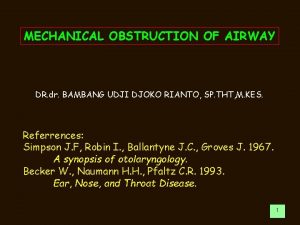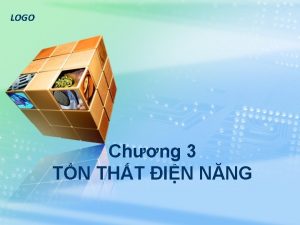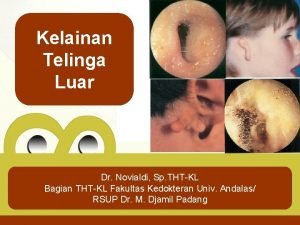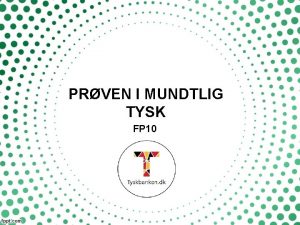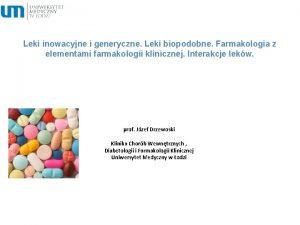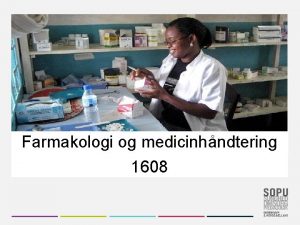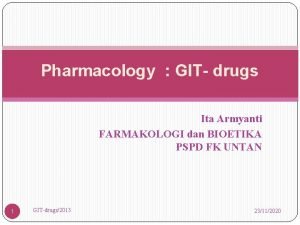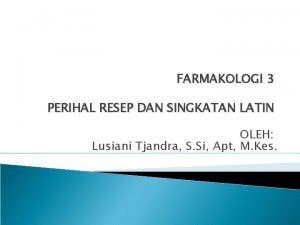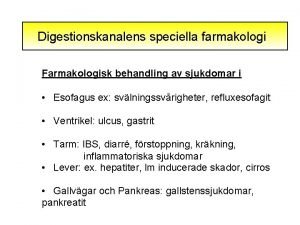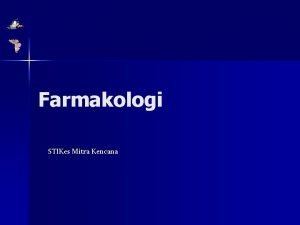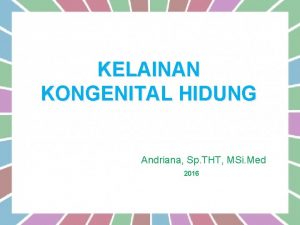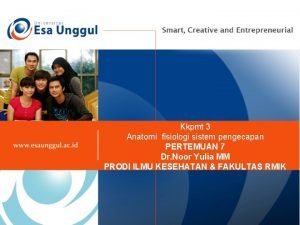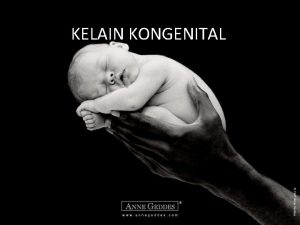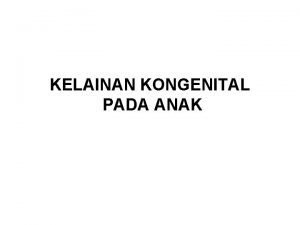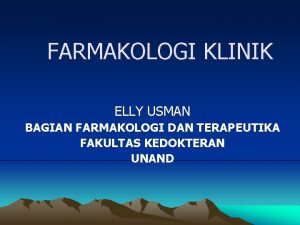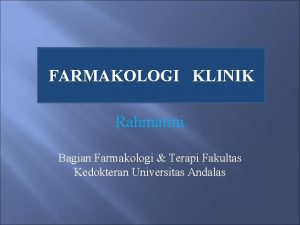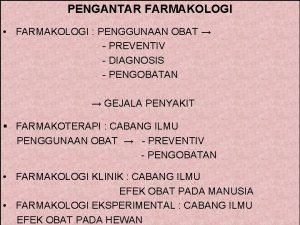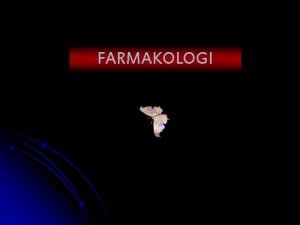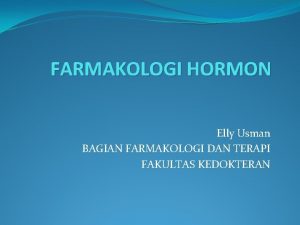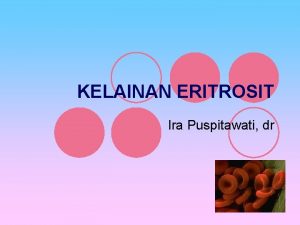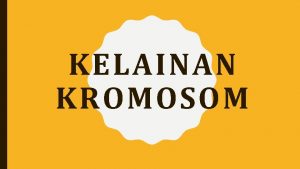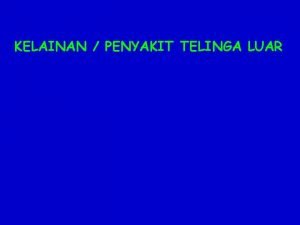FARMAKOLOGI KLINIK GANG SISTEM INDRA Kelainan di THT




















- Slides: 20

FARMAKOLOGI KLINIK GANG. SISTEM INDRA

Kelainan di THT Prinsip - Paling banyak infeksi bakteri - Pilih yang selektif Systemic therapy with phenoxymethylpenicillin (penicillin V), erythromycin or whem H. influenzae is likely involved, amoxilin/clavulanic acid, cotrimoxazole or cefaclor, and topical use og gentamicin, cover the common causative organisms.

• Measures directed at attaining a clear canal or nasal airway and enhancing eustachian tube function, are also important in a number of disorders involving the ear or nose. • Allergy can be implicated in some nasal disorders and is often associated with secretory otitis media • Treatment of vertigo is guided on the basis of careful history and investigation such as that the most likely causes can be identified and appropriate antivertigo drug ( or other treatment) selected • Some drugs cause ototoxicity, most case being associated with aminoglicoside antibacterial drugs and loop diuretics used in patients with impaired renal function

Kelainan mata Visus paling penting Optimum management of eye diseases involves (for diabetic retinopaty, open angle -glaucoma) rapid diagnosis and treatment - Corneal ulcer - Injury - Narrow angle glaucoma - cataract - dry eye To determine the most appropriate options

• Should be treated and recommendations for nutritional suplementation (vitamin, zinc, where appropriate) made for degenerative diseases of the eye • For drug administered topically to the eye, both the physicochemical properties of the drug (and its vehicle) and the physiological state of the eye affect penetration into eye structures • Therapeutic drugs concentration in the cornea and aqueous humour can be maintained or increased by prolonging drug contact with the eye by means of ointments, gels, controlled-release insert, contact lenses or collagen shields

• Intraocular drug concentration adequate for the treatment of anterior segment disease can usually achieved by topical administration. • Higher concentrations in the eye can be achieved with subconjuctival or subtenon injection, soaked collagen shields or contact lense, or (rarely) intravenous treatment • The therapy of posterior eye disorder requires retrobulbar or systemic drug therapy. Occasionally, vitrectomy and intraocular drugs are necessary.

• Drug induced eye disease my be produced by a wide variety of drug used systemically and locally to treat disease in all systems of the body as well as in the eye. • Locally and systemically administered corticosteroid and systemic phenothiazines are important examples, however there are numerous photosensitising drugs that may accelerate cataract formation • The benefit and risks of long term intraocular medications must be weighted against those surgical intervensions. Topical eye medications, particularly those used in glaucoma therapy, can be responsible for systemic adverse effect • Laser and surgical intervensions provide alternatives in therapy of cataract, glaucoma and certain retinal disorders. The choice is determined by urgency, cost and individual variation.

Kelainan Kulit • In Planning rational treatment, it is important to know whether the disease is confined to the skin, and when organs are involved, to know wether the primary fault is internal or in the skin • Especially when the disease is confined to the skin, topical as well as systemic treatment can often be used • There is usually some good reason if topical treatment is unsatisfactory, e. g. the drug is irritant or sensitising, or does not adequately penetrate the skin • The base in which a drug is applied to the skin is important. In general, lotions and pastes are best for weeping lesions and greasy ointments for dry lesions, while creams are suitable for either.

• In some skin diseases, considerable reliance is placed on symptomatic treatment • The placebo effect is large in a number of skin disease but if a placebo is to be used, it should be harmless • Drug induced skin disease is common. There are fews that have never caused a skin eruption. Drug rashes are of many different types. Only a few are produced by a known immunological mechanism • Proof that a given drug is responsible for a rash is often difficult to obtain. Nevertheless, in general, it is important to stop the drug or drugs thought most likely to be responsible especially whhen the drug is known to have severe effects on the skin or adverse systemic effects

Topical Preparations Knowledge of drug properties and a physiological understanding of skin relates to therapeutic efficacy of agent. Skin is a natural barrier of protection for the human body As with every aspect of human existence there is plethora of clinical conditions that affect skin – need a pharmacological intervention Remember that incorrect decisions about method of administration and composition of the pharmacological agent severely effects treatment efficacy (and ultimately patient care).

Skin Biology Epidermis: Outermost layer Dermis: Contains small capillaries, glands, nerve fibres & hair follicles Subcutaneous (Hypodermia): Arterioles, fat, collagen, fibroblasts

Decreasing Resistance Epidermal layers: Strateun corneum (epidermis layer) is 40% protein, 40% water and 20% lipids (fat) �Keratinization – protective production of keratin Stratum lucidium – densely packed with keratin Stratum granulosum – contains non-dividing keratinocytes Stratum spinosum – contains keratinocytes and Langerhan cells (immunity) Stratum germinativum – contact area between epidermis and dermal layer

Administration Topically – outer layer of the skin Most act on the skin but are not absorbed (soften, disinfect or lubricate). Few contain enzymes to remove superficial debris (skin ulcerations) Others treat skin infections Transdermally – through a patch or inhaled Readily absorbed with systemic effects Patches – gradual release, reducing toxicity effects Fewer adverse reactions Eg. Nitroglycerin (Cardiac Pts) and Scopolamine (nausea)

Routes Must have to penetrate cutaneous layer to exert effects. Percutaneous absorption involves: Dissolution of drug in its vehicle Diffusion of drug from vehicle to surface of skin Penetration through skin layers NB: Passage is slowest in the stratum corneum

Factors that effect cutaneous absorption Transcellular Diffusion through channels between epidermal cells Diffusion through sebaceous ducts Diffusion through hair follicles Diffusion through sweat ducts

Factors affecting absorption Nature of skin: With a skin lesion 80% can penetrate, with intact skin only 1% (hydrocortisone) Hydration improves this rate (occulsive dressings) Thin layer of stratum corneum (infant & elderly) Nature of drug: Active drug concentration, composition, physiochemical properties and base vehicle Lipid soluble more effective than water soluble (20% fat)

Exogenous factors effecting efficacy Potency levels do not last forever – expiry dates relates to a 10% decrease Environmental: p. H – affects chemical reaction and potency levels Temp – increase relates to an increase in chemical reactions O 2 - presence of O 2 can lead to degradation of agents Light – induction of photochemical degradation Humidity – can lead to dehydration of preparations

Terminology Description Conditions Astringents A coagulating protein that acts upon oozing discharge or bleeding Dermatitis Collodions Proxylin + ether/alcohol leaving a covering film Minor wounds Creams Water-soluble agents or oil based. Can contain water repellent agents Irritation or rehydration Emollients Fats or oils in a 2 phase system (1 dispersed over the other). Form a occlusive film over the skin to protect or soften. Eczema and psoriasis Gels Jelly-like solids or semi-solid perparations with a water (lubrication) or alcohol base (drying or cooling) Dry scaling lesions in the skin and scalp Humectants Substances to promote water retention Dry lesions Liniments Viscous agents contain pain-relieving analgesics Pain intact skin lesions

Terminology Description Conditions Lotions Aqueous agents to cool areas Inflamed but still intact skin Ointments Semi-solid, greasy and water insoluble preparations. Base vehicle is usually paraffin. Fungal infections of the skin Pastes High propotions of fine power solids (zinc oxide) Subacute lichenified or excoriated conditions Suspensions Undissolved drugs in liquid vehicles Various conditions

PATIENTS Management Keep out of reach of disoriented people Order pts to use corticosteroids sparingly Does the application area need to be specially prepared, covered or left exposed? Only apply to the area that needs it Wear gloves!! Use common sense Discontinue Rx if adverse reactions occur
 Keratomalasi
Keratomalasi Dr umi rahayu sp tht
Dr umi rahayu sp tht Limphoid
Limphoid Tht logo
Tht logo Dr. novialdi sp.tht
Dr. novialdi sp.tht Mundtlig tysk b
Mundtlig tysk b Auc farmakologia
Auc farmakologia Farmakologi opgave ssa praktik 2
Farmakologi opgave ssa praktik 2 Taburia 2020
Taburia 2020 Garg dalam resep
Garg dalam resep Oksitosik
Oksitosik Acetylkolin hormon
Acetylkolin hormon Papaverin ibs
Papaverin ibs Farmakodinamik adalah
Farmakodinamik adalah Peta konsep rangka manusia
Peta konsep rangka manusia Kelainan kongenital hidung
Kelainan kongenital hidung Distosia kelainan jalan lahir
Distosia kelainan jalan lahir Indra dreika
Indra dreika 2/3 anterior lidah dipersarafi
2/3 anterior lidah dipersarafi Indra nooyi is an indian born business executive
Indra nooyi is an indian born business executive Adhi indra hermanu
Adhi indra hermanu
